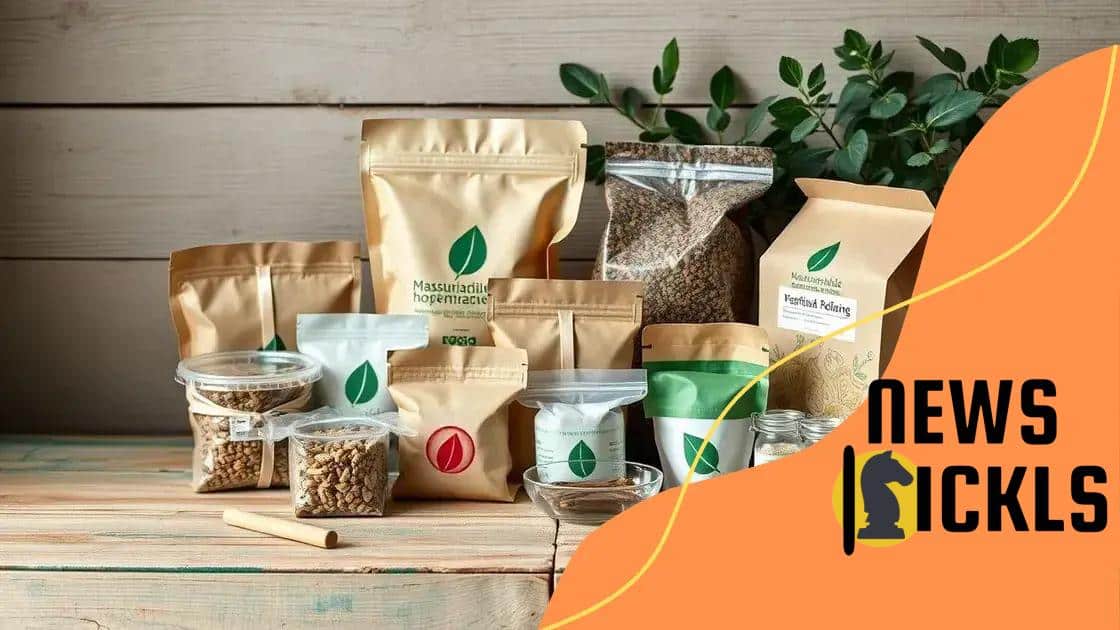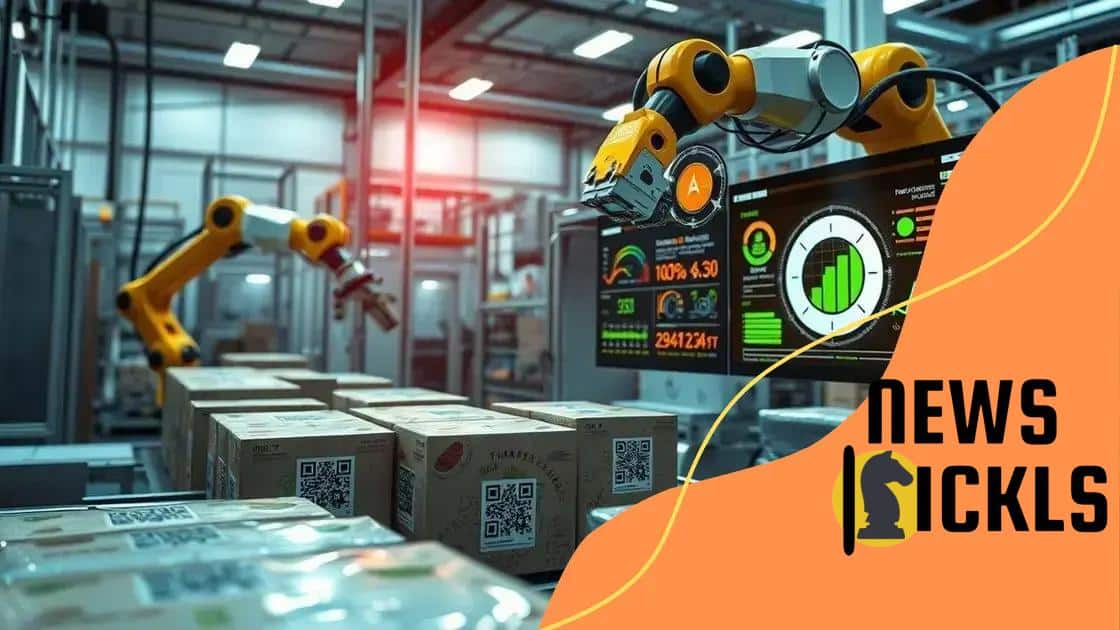Innovations in sustainable packaging solutions in 2025

Implementing sustainable packaging solutions faces challenges such as high costs, supply chain difficulties, consumer awareness, and regulatory compliance, yet overcoming these can enhance brand loyalty and contribute positively to the environment.
Innovations in sustainable packaging solutions in 2025 are not just buzzwords; they represent a real shift in how products are packaged. Are you curious about how these advancements could impact your choices as a consumer? Let’s dive in!
Emerging trends in sustainable packaging
As environmental concerns grow, emerging trends in sustainable packaging are gaining momentum across industries. This shift not only addresses ecological challenges but also enhances brand reputation among consumers who value eco-friendliness.
Biodegradable Materials
One of the most exciting trends is the use of biodegradable materials. These materials break down naturally, which means they don’t linger in landfills. Companies are increasingly turning to alternatives like starch-based plastics and mushroom-based packaging. These options offer viable replacements for traditional plastics.
Minimalist Packaging
Simplicity is key! Minimalist packaging reduces excess waste and often lowers production costs. Brands are adopting this approach by using fewer materials while maintaining product safety and integrity. This trend aligns with consumers’ desires for less wasteful practices.
- Fewer layers of packaging
- Simpler designs
- Emphasis on recyclability
Another fascinating aspect is the rise of reusable packaging. More companies are promoting systems where consumers return containers for reuse. This not only lessens waste but also fosters customer loyalty. Consumers enjoy being part of the solution, which enhances their connection to brands.
Smart Packaging Technology
With technological advancements, smart packaging is becoming increasingly popular. This includes QR codes and sensors that provide information about a product’s freshness or sustainability practices. These features engage consumers and encourage smarter purchasing decisions.
- Scan to learn more about materials
- Real-time freshness tracking
- Educational content on sustainability
As we progress, these emerging trends in sustainable packaging will likely continue to evolve. Social media and consumer feedback play a vital role in shaping these innovations. Ultimately, adapting to these trends not only benefits the planet but also positions companies as leaders in sustainability.
Key materials for eco-friendly packaging
In the world of sustainable packaging, understanding the key materials for eco-friendly packaging is crucial. These materials not only reduce the environmental impact but also help businesses appeal to eco-conscious consumers.
Recycled Paper and Cardboard
One of the most common and effective materials is recycled paper and cardboard. These materials are widely used because they are renewable and recyclable. Brands are choosing to package products with paper that is either recycled or sourced from responsibly managed forests.
Bioplastics
Bioplastics are another innovative alternative to conventional plastics. Made from natural sources like corn starch or sugarcane, they can decompose more easily in the environment. This shift helps reduce dependency on fossil fuels and promotes a circular economy.
- Compostable options for food packaging
- A variety of applications, from bags to containers
- Less carbon footprint compared to traditional plastics
Natural fibers like bamboo and hemp are also gaining popularity. These fibers provide strong, durable materials for packaging while being biodegradable. As they break down naturally, they leave less waste behind.
Glass and Metal
When it comes to reusable packaging, glass and metal are excellent choices. Both materials are infinitely recyclable, making them sustainable options. They are often used for containers and bottles, and their ability to preserve products without chemicals is a big advantage.
- Glass jars for food and cosmetics
- Aluminum cans for beverages
- Durability and safety for consumers
As businesses grow more aware, the use of these key materials for eco-friendly packaging will influence their success and sustainability efforts. It’s essential to stay updated on these developments to make informed choices and meet changing consumer demands.
The role of technology in packaging sustainability

The role of technology in packaging sustainability is rapidly growing, transforming how products are packaged and delivered. Through innovation, businesses are finding ways to reduce waste and improve efficiency.
Smart Packaging Solutions
Smart packaging is gaining traction in the industry. This technology includes features like QR codes and NFC chips, allowing consumers to access information about a product’s origin and sustainability efforts. By providing transparency, brands can build trust and loyalty with their customers.
Advanced Material Development
Technology is also leading to the development of new materials that are more sustainable. For example, researchers are creating innovative biodegradable materials that can replace traditional plastics. These materials can break down naturally without harming the environment.
- Innovations in plant-based plastics
- Using less energy in production
- Improved recycling technologies
Automation plays a positive role in production efficiency. By using automated systems, companies can minimize waste during the packaging process. This technology allows for precise measurements and reduces errors, resulting in less material waste overall.
Data Analytics for Decision Making
Utilizing data analytics helps businesses track their environmental impact. Companies can analyze supply chains and identify areas where they can improve sustainability. This approach enables them to make informed decisions about materials and processes.
- Monitoring carbon footprints
- Evaluating waste management practices
- Making data-driven improvements
The advancement of technology is essential in driving sustainability efforts forward. By embracing these innovations, companies not only contribute to a healthier planet but also respond to increasing consumer demand for eco-friendly practices.
Case studies of successful sustainable packaging
Exploring case studies of successful sustainable packaging offers valuable insights into how companies have effectively integrated eco-friendly practices. These examples demonstrate that sustainability is not just possible; it can also be profitable.
Company A: Coca-Cola’s PlantBottle
Coca-Cola launched its innovative PlantBottle, made from up to 30% renewable plant materials. This packaging has significantly reduced the company’s carbon footprint and uses less petroleum-based plastic. The PlantBottle is fully recyclable, which enhances its sustainability profile.
Company B: Unilever’s Sustainable Living Plan
Unilever has committed to making all its plastic packaging recyclable, reusable, or compostable by 2025. They incorporate recycled materials in their packaging as part of their Sustainable Living Plan. This initiative not only reduces waste but also appeals to consumers who prioritize eco-friendly products.
- Development of refillable packaging options
- Investment in biodegradable materials
- Focus on reducing plastic waste
Another notable success is the collaboration between LEGO and the sustainable packaging company. They developed bio-based plastic from sugarcane for their packaging. This decision aligns with their long-term goal of achieving more sustainable materials by 2030. LEGO’s commitment exemplifies how even large brands can leverage sustainability to meet consumer demands.
Company C: Method’s Eco-Friendly Cleaning Products
Method, a cleaning product company, uses packaging made from recycled materials and offers refillable options. Their brightly colored bottles are popular among consumers, showing that sustainability can also be attractive. By emphasizing design and eco-friendliness, Method has carved out a niche in a crowded market.
- Self-dispensing containers for convenience
- Partnerships with environmental organizations
- Transparent communication on sustainability efforts
These case studies of successful sustainable packaging highlight the innovative approaches companies take to address environmental challenges. By learning from these examples, other businesses can incorporate similar strategies and contribute to a more sustainable future.
Challenges in implementing sustainable packaging solutions
Implementing sustainable packaging solutions brings various challenges that companies must navigate. While many businesses strive for eco-friendly practices, several obstacles can hinder their progress.
Cost Constraints
One major challenge is the cost of sustainable materials. Often, eco-friendly alternatives are more expensive than traditional options. This can lead businesses to hesitate in making the switch, especially smaller companies with limited budgets. Additionally, the initial investment in new technologies for sustainable packaging can be daunting.
Supply Chain Issues
Another significant barrier involves the supply chain. Sourcing sustainable materials can be difficult, as not all suppliers offer eco-friendly options. This can create delays and complicate production processes. Companies may struggle to find reliable sources that meet both quality and sustainability standards.
- Limited availability of biodegradable materials
- Inconsistent quality of sustainable products
- Challenges in logistics and distribution
Consumer perception also plays a key role in the transition to sustainable packaging. Many consumers are not yet fully aware of the benefits of eco-friendly options. Some may even resist changes if they perceive sustainable packaging as inferior or less functional.
Regulatory Compliance
Moreover, understanding and complying with regulations can be challenging. Packaging regulations vary widely by region, adding another layer of complexity for businesses. Companies must stay informed about changing laws to ensure their packaging meets compliance requirements.
- Awareness of local and regional regulations
- Need for continuous monitoring of compliance changes
- Potential fines for non-compliance
Despite these challenges, many businesses recognize the importance of shifting toward sustainable practices. By addressing the obstacles head-on, companies can pave the way toward more environmentally friendly packaging solutions. Ultimately, the benefits of sustainable packaging, such as improving brand image and meeting consumer demand, make it a worthwhile investment.
\n
FAQ – Frequently Asked Questions about Sustainable Packaging Solutions
What are the main challenges of implementing sustainable packaging?
The main challenges include cost constraints, supply chain issues, consumer awareness, and regulatory compliance.
How can companies reduce costs related to sustainable packaging?
Companies can reduce costs by sourcing materials in bulk, collaborating with sustainable suppliers, and investing in efficient technologies.
What are the benefits of switching to sustainable packaging?
Switching to sustainable packaging can enhance brand loyalty, attract eco-conscious consumers, and improve regulatory compliance.
How does consumer perception affect sustainable packaging decisions?
Consumer perception is crucial; if consumers prioritize eco-friendly practices, companies may feel encouraged to adopt sustainable solutions.






